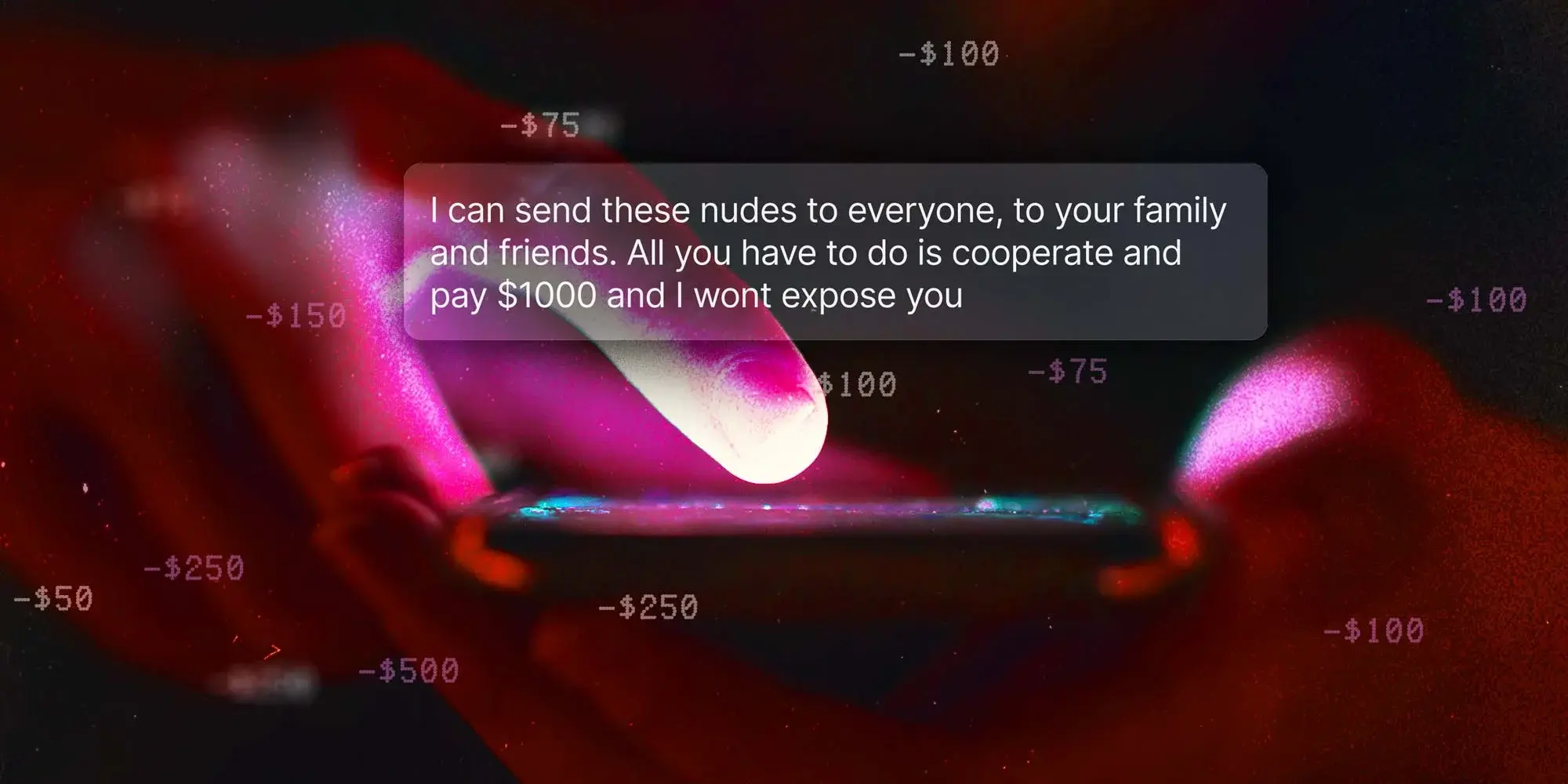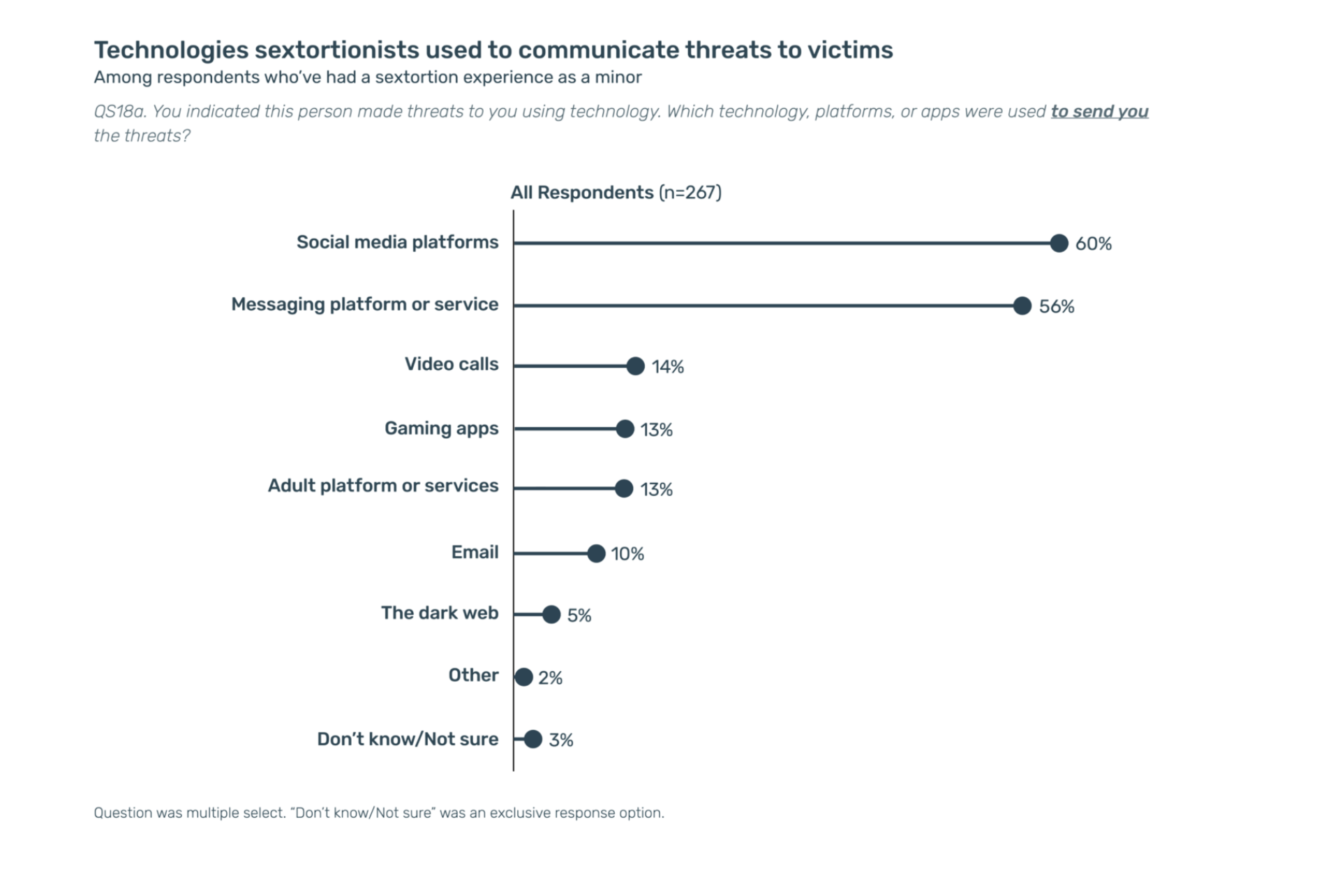Evan 16, was an avid outdoorsman and a varsity soccer player. He was kind, intelligent, and wanted to be a professional fisherman when he grew up. But he never got the chance.
One normal day Snapchat user JennyTee60 added him on the platform, posing as a young girl. They began chatting and eventually exchanged sexually explicit images. Within minutes, he was blackmailed.
“I have your nudes and everything needed to ruin your life”.
The scammers behind the fake JennyTee60 profile demanded money and threatened to release the images of Evan to everyone he knew. Feeling like there was no way out, Evan took his own life just 2 hours after the initial messaging exchange began.
It’s so easy to think, reading Evan’s story…
or Jordan’s
or James
or Braden’s
or Amanda’s
or Riley’s story,
That, while tragic, it won’t happen to you or anyone you know.
While we’d love to tell you that’s probably true, the rate at which sextortion is rising paints a less hopeful picture.
In 2023 alone, the National Center for Missing and Exploited Teens (NCMEC) received 812 weekly reports of sextortion, and those numbers keep rising. In 2024, the FBI received 55,000 reports. The recent report by Thorn in partnership with NCMEC shows just how widespread this issue is.
Sextortion Re-cap
Let’s call sextortion what it is: exploitation and abuse. Sextortion is most often defined as when someone threatens you to distribute private or intimate images, unless the victim complies with demands—whether that means sending more sexual content, paying money, or staying in a relationship they don’t want.
While perpetrators often trick and coerce their victims into sending sexually explicit images of themselves, it’s not always the case. Scammers can easily manipulate images using AI to appear as if they are the victim. The photos are so realistic that many people succumb to the blackmail out of fear that the pictures will be circulated.
The reality is that these scammers have found the most success targeting young people, especially young boys.
The BBC actually recently spoke with a Nigerian sextortionist, who explained why they target young boys. He said,
“Because their sex drive is so high, and young boys are scared of their pictures being released to their class groups, their parents, and their friends.”
When the interviewee mentioned how this type of exploitation could easily ruin someone’s life, he replied,
“I don’t feel bad because I need the money.”
What’s especially alarming is that it’s not always some anonymous predator in another country, like in the case of Evan. More than one in three victims knew their extortionist offline. It could be a classmate, an ex, or a so-called “friend”.
It starts under the guise of trusted profiles, through peers, or even from kids down the hall. In 2025, this form of abuse has become a silent epidemic.
Thorn’s research found that 39% of victims were coerced into sending more sexual images, and 31% were pressured to meet offline. Others were blackmailed into sexual acts over video, staying in a relationship against their will, or even handing over money and gift cards.
Perhaps most gut-wrenching of all: 15% of victims reported self-harming after being threatened.
These predators thrive in the dark. The less we talk about sextortion, the stronger they become.
The Alarming Rise
Again, we will say this: If this feels like a niche problem, think again.
Thorn’s latest report shows that 1 in 5 teens (20%) say they’ve experienced sextortion.
The FBI and Homeland Security logged more than 13,000 reports of online sexual extortion of minors in just 18 months between 2021 and 2023, and 55,000 in 2024. Rates are up anywhere from 300% to 1,000%.
Financial sextortion, especially, is on the rise. Predators aren’t only asking for more images—they’re demanding cash. Almost every one of these schemes begins on digital platforms. According to Thorn, 94% of threats happen in social media apps or private messages.
Almost anywhere you can access the internet or connect with another person is where sextortion can happen. Consider social media, gaming systems, forums, and other similar platforms.
And here’s the kicker: because many cases start in the context of a “relationship,” the detection systems built to flag threats often don’t catch them. Kids are suffering in plain sight, and the platforms are missing it.
Real Stories Behind the Numbers
Headlines are starting to reflect the reality.
In New York this year, police arrested a middle school student in Stony Point for allegedly running a sextortion scheme that could involve hundreds of victims. Investigators say the student posed as a girl online, convinced male classmates to send explicit images, then threatened to expose them unless they sent more—or paid up. So far, six victims have been confirmed, but officials believe the number is far higher.
Around the same time, Rockland County media reported multiple sextortion investigations involving kids at local elementary and middle schools.
Let that sink in: children in middle school are running and being targeted by sextortion schemes. This is not “a teen issue.” It’s a community crisis.
Why Kids Are So Vulnerable
The reasons are painfully clear. Kids are online earlier than ever. They’re navigating identity, relationships, and self-worth in front of an audience. That makes them easier to manipulate.
Predators use grooming tactics—flattery, fake empathy, peer pressure. By the time kids realize they’re trapped, it feels too late. Add in new tech, and the stakes rise: with AI and deepfakes, predators can fabricate explicit images of victims who never even sent one in the first place.
Victims often stay silent, believing they’ll be blamed or punished. Thorn found that about 1 in 7 victims never told anyone what happened.
Meanwhile, predators are adapting faster than platforms. International networks coordinate sextortion campaigns, exploiting weak spots in reporting systems and the anonymity of virtual currencies.
Sextortion can destroy self-worth, push kids into isolation, and lead to self-harm. Thorn found that 15% of victims hurt themselves after being targeted. LGBTQ+ youth—who already face disproportionate harassment—are especially vulnerable.
What We Can Do
Here’s the truth: sextortion thrives in the dark—all of those young boys who took their own lives suffered in silence behind closed doors. The only way to fight it is to drag it into the light.
Here are some commonly reported indications that sextortion or unsafe behavior or exploitation may happen.
🚨 Warning Signs of Predators on Social Media:
-
No mutual friends with the person messaging you
-
Profile pics look blurry, edited, or “off” (even realistic accounts can be faked)
-
Very few—or way too many—followers
-
Messages with bad grammar, weird wording, or strange slang
-
New followers who immediately push the conversation toward romance or sexual topics
-
Requests to move the chat off social media to private apps
- Immediately asking for nude or partially nude images
Tip: If something feels off, trust your gut. Block, report, and tell someone.
Parents, teachers, and mentors, we must have conversations. Not in hushed tones. Not as “something that happens to other people.” But as an urgent safety issue, just like bullying or drugs.
Kids need to know sextortion is a crime. It’s not their shame to carry.
Adults must respond with compassion. When a child discloses, the last thing they need is judgment. They need protection and healing. Platforms must build reporting tools that actually work.
If you or someone you know has been a victim of sextortion, here are some tips on what to do.
- Do not give in to the perpetrator’s demands; do not send money, more pictures, or any other form of payment.
- Screenshot all interactions
- Block the sender
- Report what happened to local law enforcement and FBI
- Send a report to NCMEC where they will connect you with additional resources specific to where you live.
Additionally, the Internet Watch Foundation (IWF) has resources where minors can confidentially report nude or sexually explicit images of themselves to get them removed online and not reuploaded.
Remember, even if you sent images, you are not the criminal; they are.
Porn, Nudes, and Sextortion
Sextortion usually starts with sending nudes—and in a world where sexual content is everywhere, predators are ready to exploit it. Porn and online culture normalize sharing explicit images, set unrealistic sexual expectations, and pressure teens to comply.
Studies show 1 in 5 girls and 1 in 10 boys aged 13–17 have shared nudes, often under coercion or peer pressure. AI and mainstream porn make the demand for sexualized content more intense than ever.
The risks are real: legal consequences, emotional harm, and vulnerability to predators. Boys and girls face different pressures, but the danger is universal.
Sextortion isn’t random—it’s a direct result of normalized sexualized sharing. Teens deserve to know their worth isn’t defined by their bodies or sexual content. Open conversations, awareness, and guidance can protect them from predators and help them build healthy, respectful relationships.
Silence is the predator’s greatest weapon. Awareness is ours. Let’s collectively warn every child we can of the realities of sextortion, equip every parent with the insight to what’s happening behind closed doors, and together flip the narrative and take away these predators’ power.
To read Thorn’s full report, click here.
Your Support Matters Now More Than Ever
Most kids today are exposed to porn by the age of 12. By the time they’re teenagers, 75% of boys and 70% of girls have already viewed itRobb, M.B., & Mann, S. (2023). Teens and pornography. San Francisco, CA: Common Sense.Copy —often before they’ve had a single healthy conversation about it.
Even more concerning: over half of boys and nearly 40% of girls believe porn is a realistic depiction of sexMartellozzo, E., Monaghan, A., Adler, J. R., Davidson, J., Leyva, R., & Horvath, M. A. H. (2016). “I wasn’t sure it was normal to watch it”: A quantitative and qualitative examination of the impact of online pornography on the values, attitudes, beliefs and behaviours of children and young people. Middlesex University, NSPCC, & Office of the Children’s Commissioner.Copy . And among teens who have seen porn, more than 79% of teens use it to learn how to have sexRobb, M.B., & Mann, S. (2023). Teens and pornography. San Francisco, CA: Common Sense.Copy . That means millions of young people are getting sex ed from violent, degrading content, which becomes their baseline understanding of intimacy. Out of the most popular porn, 33%-88% of videos contain physical aggression and nonconsensual violence-related themesFritz, N., Malic, V., Paul, B., & Zhou, Y. (2020). A descriptive analysis of the types, targets, and relative frequency of aggression in mainstream pornography. Archives of Sexual Behavior, 49(8), 3041-3053. doi:10.1007/s10508-020-01773-0Copy Bridges et al., 2010, “Aggression and Sexual Behavior in Best-Selling Pornography Videos: A Content Analysis,” Violence Against Women.Copy .
From increasing rates of loneliness, depression, and self-doubt, to distorted views of sex, reduced relationship satisfaction, and riskier sexual behavior among teens, porn is impacting individuals, relationships, and society worldwideFight the New Drug. (2024, May). Get the Facts (Series of web articles). Fight the New Drug.Copy .
This is why Fight the New Drug exists—but we can’t do it without you.
Your donation directly fuels the creation of new educational resources, including our awareness-raising videos, podcasts, research-driven articles, engaging school presentations, and digital tools that reach youth where they are: online and in school. It equips individuals, parents, educators, and youth with trustworthy resources to start the conversation.
Will you join us? We’re grateful for whatever you can give—but a recurring donation makes the biggest difference. Every dollar directly supports our vital work, and every individual we reach decreases sexual exploitation. Let’s fight for real love:





